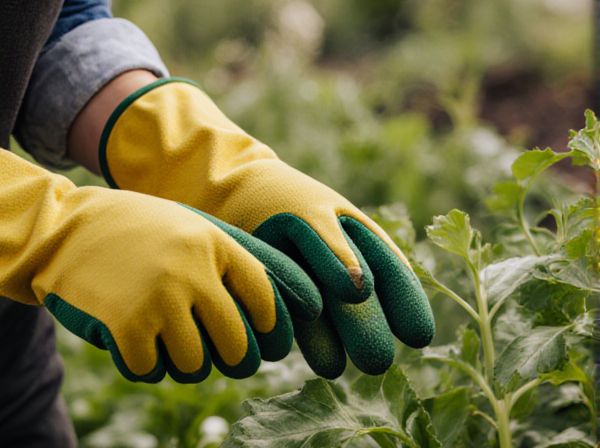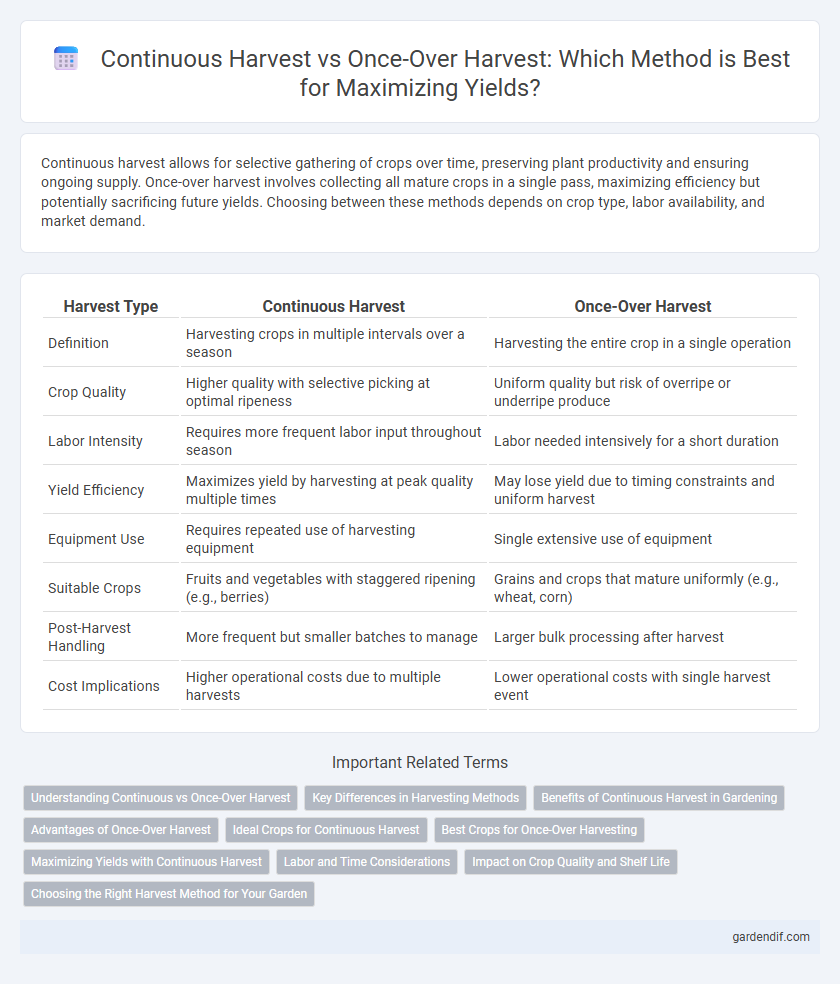
Continuous Harvest vs Once-Over Harvest Illustration
Continuous harvest allows for selective gathering of crops over time, preserving plant productivity and ensuring ongoing supply. Once-over harvest involves collecting all mature crops in a single pass, maximizing efficiency but potentially sacrificing future yields. Choosing between these methods depends on crop type, labor availability, and market demand.
Table of Comparison
| Harvest Type | Continuous Harvest | Once-Over Harvest |
|---|---|---|
| Definition | Harvesting crops in multiple intervals over a season | Harvesting the entire crop in a single operation |
| Crop Quality | Higher quality with selective picking at optimal ripeness | Uniform quality but risk of overripe or underripe produce |
| Labor Intensity | Requires more frequent labor input throughout season | Labor needed intensively for a short duration |
| Yield Efficiency | Maximizes yield by harvesting at peak quality multiple times | May lose yield due to timing constraints and uniform harvest |
| Equipment Use | Requires repeated use of harvesting equipment | Single extensive use of equipment |
| Suitable Crops | Fruits and vegetables with staggered ripening (e.g., berries) | Grains and crops that mature uniformly (e.g., wheat, corn) |
| Post-Harvest Handling | More frequent but smaller batches to manage | Larger bulk processing after harvest |
| Cost Implications | Higher operational costs due to multiple harvests | Lower operational costs with single harvest event |
Understanding Continuous vs Once-Over Harvest
Continuous harvest involves regularly collecting crops throughout the growing season, ensuring fresh produce and reducing waste by harvesting at optimal ripeness. Once-over harvest gathers all crops in a single pass, maximizing efficiency in labor and equipment use but may sacrifice quality by including less ripe or overripe produce. Understanding the trade-offs between these methods helps optimize crop yield, quality, and market timing for different agricultural operations.
Key Differences in Harvesting Methods
Continuous harvest involves regularly collecting mature crops over an extended period, ensuring sustained yield and minimal waste, while once-over harvest gathers the entire crop in a single pass, often leading to faster processing but potential quality variation. Continuous harvest optimizes ongoing production with selective picking, beneficial for crops with staggered ripening, whereas once-over harvest suits uniform crops ready simultaneously. Machinery and labor requirements differ significantly, with continuous harvest demanding repetitive operations and once-over harvest requiring intensive short-term efforts.
Benefits of Continuous Harvest in Gardening
Continuous harvest in gardening maximizes yield by allowing regular picking of produce, which encourages plants to produce more over an extended period. This method reduces waste by harvesting only ripe fruits and vegetables, improving freshness and nutrient retention. It also optimizes space usage, enabling gardeners to grow multiple crops in succession without downtime.
Advantages of Once-Over Harvest
Once-Over Harvest offers efficient crop collection by reducing labor costs and time, maximizing operational efficiency during peak ripeness. This method minimizes crop damage and loss due to reduced handling, ensuring higher quality yield. Farmers benefit from synchronized harvesting schedules that align with market demand and optimal crop conditions.
Ideal Crops for Continuous Harvest
Leafy greens like lettuce, spinach, and kale are ideal crops for continuous harvest due to their ability to regenerate leaves quickly, allowing multiple pickings over a growing season. Herbs such as basil, mint, and cilantro also thrive in continuous harvest systems, providing a steady supply of fresh foliage without compromising plant health. This method increases yield efficiency and reduces waste compared to once-over harvest, which is better suited for crops like root vegetables and grains that require a single, complete harvest.
Best Crops for Once-Over Harvesting
Best crops for once-over harvesting include small grains like wheat, barley, and oats due to their uniform maturation, which allows efficient mechanical harvesting in a single pass. Root vegetables such as potatoes and carrots also lend themselves well to once-over harvest because of their soil stability and synchronized growth cycles. Legumes like soybeans are another ideal choice, benefiting from consistent crop ripening that reduces the need for multiple harvest rounds.
Maximizing Yields with Continuous Harvest
Continuous harvest techniques enhance crop yields by allowing multiple pickings throughout the growing season, ensuring fruits and vegetables are harvested at peak ripeness. Unlike once-over harvest, which gathers all produce at a single time and risks overripe or underripe losses, continuous harvest maintains consistent quality and volume. This method optimizes resource use and increases overall productivity, benefiting both small-scale farmers and commercial operations.
Labor and Time Considerations
Continuous harvest requires ongoing labor input and allows for staggered worker deployment, optimizing time efficiency throughout the growing season. Once-over harvest concentrates labor into a short, intensive period, demanding a larger workforce for rapid crop collection. Choosing between these methods impacts labor scheduling, overall time management, and operational costs in agricultural production.
Impact on Crop Quality and Shelf Life
Continuous harvest techniques maintain optimal crop quality by allowing selective picking of mature produce, reducing stress and damage to plants, which enhances shelf life through fresher, less bruised items. In contrast, once-over harvest methods can cause increased mechanical injury and rapid crop degradation due to bulk harvesting at a single time, negatively impacting both quality and longevity. Studies show continuous harvesting leads to consistent produce quality, minimizing post-harvest losses and extending marketability.
Choosing the Right Harvest Method for Your Garden
Continuous harvest allows gardeners to pick crops like lettuce and herbs regularly throughout the growing season, promoting fresh produce and reducing waste. Once-over harvest is ideal for crops such as root vegetables and grains, where a single, comprehensive harvest maximizes yield efficiency. Selecting the appropriate harvest method depends on crop type, garden size, and desired freshness, ensuring optimal productivity and resource management.
Continuous Harvest vs Once-Over Harvest Infographic

 gardendif.com
gardendif.com